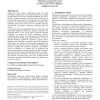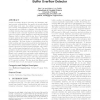SIGSOFT
2008
ACM
15 years 7 days ago
2008
ACM
Developers perform small-scale reuse tasks to save time and to increase the quality of their code, but due to their small scale, the costs of such tasks can quickly outweigh their...
SIGSOFT
2008
ACM
15 years 7 days ago
2008
ACM
Software fails and fixing it is expensive. Research in failure prediction has been highly successful at modeling software failures. Few models, however, consider the key cause of ...
SIGSOFT
2008
ACM
15 years 7 days ago
2008
ACM
Getting the right software requirements under the right environment assumptions is a critical precondition for developing the right software. This task is intrinsically difficult....
SIGSOFT
2008
ACM
15 years 7 days ago
2008
ACM
Modern Web 2.0 applications, such as GMail, Live Maps, Facebook and many others, use a combination of Dynamic HTML, JavaScript and other Web browser technologies commonly referred...
SIGSOFT
2008
ACM
15 years 7 days ago
2008
ACM
Framework-intensive applications (e.g., Web applications) heavily use temporary data structures, often resulting in performance bottlenecks. This paper presents an optimized blend...
SIGSOFT
2008
ACM
15 years 7 days ago
2008
ACM
Software teams should follow a well defined goal and keep their work focused. Work fragmentation is bad for efficiency and quality. In this paper we empirically investigate the re...
SIGSOFT
2008
ACM
15 years 7 days ago
2008
ACM
Runtime monitoring allows programmers to validate, for instance, the proper use of application interfaces. Given a property specification, a runtime monitor tracks appropriate run...
SIGSOFT
2008
ACM
15 years 7 days ago
2008
ACM
To better understand what makes Application Programming Interfaces (APIs) hard to use and how to improve them, recent research has begun studying programmers' strategies and ...
SIGSOFT
2008
ACM
15 years 7 days ago
2008
ACM
NesC is a programming language for applications that run on top of networked sensor nodes. Such an application mainly uses an interrupt to trigger a sequence of operations, known ...
SIGSOFT
2008
ACM
15 years 7 days ago
2008
ACM
Despite increasing efforts in detecting and managing software security vulnerabilities, the number of security attacks is still rising every year. As software becomes more complex...


